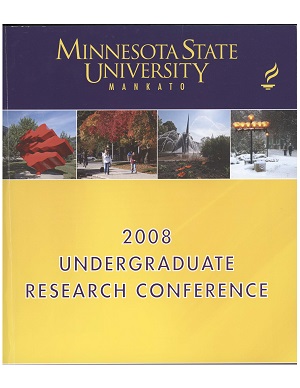Identification and Stability of Cadmium-Fluoroquinolone Antibiotic Complexes in the Presence and Absence of Clay Minerals
Location
CSU Ballroom
Start Date
21-4-2008 1:00 PM
End Date
21-4-2008 3:00 PM
Student's Major
Chemistry and Geology
Student's College
Science, Engineering and Technology
Mentor's Name
Trent P. Vorlicek
Mentor's Department
Chemistry and Geology
Mentor's College
Science, Engineering and Technology
Description
Soils treated with sludge or manure experience elevated levels of heavy metals and fluoroquinolone (FQ) antibiotics. Given the well-documented stability of metal-FQ complexes, metal and FQ association within soils is likely. The presence of metal-FQs in soils is a public health concern because these complexes often exceed the antimicrobial activity of free FQs. Unfortunately, there is scarce information concerning the chemistry governing aqueous-phase metal-FQ formation in soils. To begin filling this void, the transition metal, Cd2+, and the common FQ, ciprofloxacin, were reacted in the presence and absence of the common clay, illite. High Performance Liquid Chromatography and Atomic Absorption Spectroscopy results indicated complexation between Cd2+ and ciprofloxacin to form an insoluble 1: 1 complex. Test slurries utilizing p-nitrophenol, a degradation product of herbicides present in many soils, as a pH buffering agent suggested that p-nitrophenol also serves as a participating ligand in the complex. A strong pH effect between pH = 6 to 8 (i.e., little to no precipitation at the lower pH) was observed for the formation of the complex in the presence of illite, implying either an aqueous phase ( e.g., protonation of the phenol) or mineral surface control (e.g., enhanced adsorption of one or more of the participating ligands) on the complexation reaction. Experiments in the absence of illite are currently underway to define the pH effect. These results demonstrate a viable reaction pathway available within soils for the formation of a complex involving three frequent soil contaminants.
Identification and Stability of Cadmium-Fluoroquinolone Antibiotic Complexes in the Presence and Absence of Clay Minerals
CSU Ballroom
Soils treated with sludge or manure experience elevated levels of heavy metals and fluoroquinolone (FQ) antibiotics. Given the well-documented stability of metal-FQ complexes, metal and FQ association within soils is likely. The presence of metal-FQs in soils is a public health concern because these complexes often exceed the antimicrobial activity of free FQs. Unfortunately, there is scarce information concerning the chemistry governing aqueous-phase metal-FQ formation in soils. To begin filling this void, the transition metal, Cd2+, and the common FQ, ciprofloxacin, were reacted in the presence and absence of the common clay, illite. High Performance Liquid Chromatography and Atomic Absorption Spectroscopy results indicated complexation between Cd2+ and ciprofloxacin to form an insoluble 1: 1 complex. Test slurries utilizing p-nitrophenol, a degradation product of herbicides present in many soils, as a pH buffering agent suggested that p-nitrophenol also serves as a participating ligand in the complex. A strong pH effect between pH = 6 to 8 (i.e., little to no precipitation at the lower pH) was observed for the formation of the complex in the presence of illite, implying either an aqueous phase ( e.g., protonation of the phenol) or mineral surface control (e.g., enhanced adsorption of one or more of the participating ligands) on the complexation reaction. Experiments in the absence of illite are currently underway to define the pH effect. These results demonstrate a viable reaction pathway available within soils for the formation of a complex involving three frequent soil contaminants.
Recommended Citation
Danberry, Aaron L.. "Identification and Stability of Cadmium-Fluoroquinolone Antibiotic Complexes in the Presence and Absence of Clay Minerals." Undergraduate Research Symposium, Mankato, MN, April 21, 2008.
https://cornerstone.lib.mnsu.edu/urs/2008/poster-session-B/24



